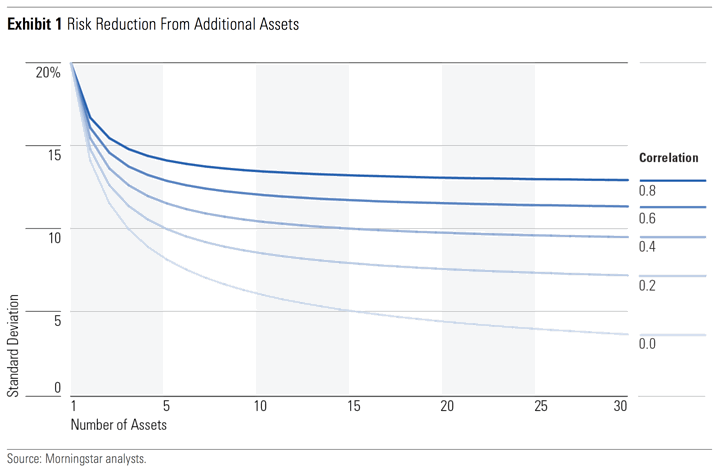
Morningstar has published their 2024 Diversification Landscape Update (direct link to PDF), another useful whitepaper for DIY investors that looks closer at the correlations between different asset classes. In their Key Takeaways, they note the quick turnaround from “The Classic 60/40 Portfolio is Dead” articles at the end of 2022 to “The Classic 60/40 Portfolio is Back!” at the end of 2023.
After a dismal year in 2022, the plain-vanilla version of a 60/40 portfolio (made up of US stocks and US investment-grade bonds) gained about 18% in 2023. Diversifying into other asset classes generally led to lower returns.
This marks a reversal from 2022 when portfolio diversification was a net positive. However, the basic 60/40 portfolio, composed of US stocks and high-quality bonds, has been tough to beat over longer periods. A 60/40 portfolio improved risk-adjusted returns versus an all-stock benchmark in more than 87% of the rolling three-year periods starting in 1976.
A potential benefit from owning multiple asset classes is that the lower the correlation between asset classes (the less they move in the same direction), the greater the reduction in volatility you get by combining assets. As long as you combine asset classes with correlations below 1 (perfectly correlated), you get some degree of volatility reduction. (See top graphic.) You can also see that the volatility reduction benefit mostly occurs within the first few asset classes; you don’t need 10 of them.
As you can see from the 60/40 Key Takeaway, the catch here is that correlations aren’t always stable. We have to look for longer historical trends with evidence that it will continue. Here are a few selected charts from the research paper.
T-Bill and Chill. Over long periods, US Treasury bonds have a lower average correlation to US stocks than a Total Bond index that includes investment-grade corporate bonds. But T-Bills (cash) get rid of the interest rate risk within T-Bonds as well, which often results in T-Bills being the most reliable shelter from the storm. You might not get a handy negative correlation boost during a stock crash, but the correlation will be reliably close to zero and your principal will be ready and waiting to deploy.

International stocks offer a small diversification benefit, but are usually strongly correlated with US stocks. (Though a little less so recently.) In the end, you must have faith that international stock returns will at times exceed US stock returns for periods of time to invest in this asset class. That faith has been tested recently, but I still would rather own them than not.

Commodities and Gold. Commodities go through boom and bust cycles as part of their nature, and the correlations with US stocks can also stay high or low for years at a time. I find it all very unreliable and unpredictable. Now, Gold has shown a consistently low correlation with US stocks, which is definitely an attractive quality. I’m more concerned about the long-term returns. Again, you need to have faith that long-term average gold returns will be well above inflation.

Long-term average correlations between asset classes. At the bottom of the whitepaper, don’t miss the charts which include correlation matrixes between major asset classes over the last 1, 3, 5, 10, 15, and 20 years.

 The Best Credit Card Bonus Offers – 2025
The Best Credit Card Bonus Offers – 2025 Big List of Free Stocks from Brokerage Apps
Big List of Free Stocks from Brokerage Apps Best Interest Rates on Cash - 2025
Best Interest Rates on Cash - 2025 Free Credit Scores x 3 + Free Credit Monitoring
Free Credit Scores x 3 + Free Credit Monitoring Best No Fee 0% APR Balance Transfer Offers
Best No Fee 0% APR Balance Transfer Offers Little-Known Cellular Data Plans That Can Save Big Money
Little-Known Cellular Data Plans That Can Save Big Money How To Haggle Your Cable or Direct TV Bill
How To Haggle Your Cable or Direct TV Bill Big List of Free Consumer Data Reports (Credit, Rent, Work)
Big List of Free Consumer Data Reports (Credit, Rent, Work)
I’ve always been confused by why a 60/40 portfolio would beat an all-stock portfolio over long periods. I think it must be because if the market falls, you’re automatically rebalancing and buying more stocks, but if the market is in a bubble, you’re selling a bit and putting it into bonds to maintain that 60/40 balance. I still don’t really own bonds because of the inflation risk.
You bring up an interesting point about International funds. I read different opinions but a lot share your perspective , they correlate with US funds but you still want to have some. For me, I’m slowly cutting down my position on International stocks.